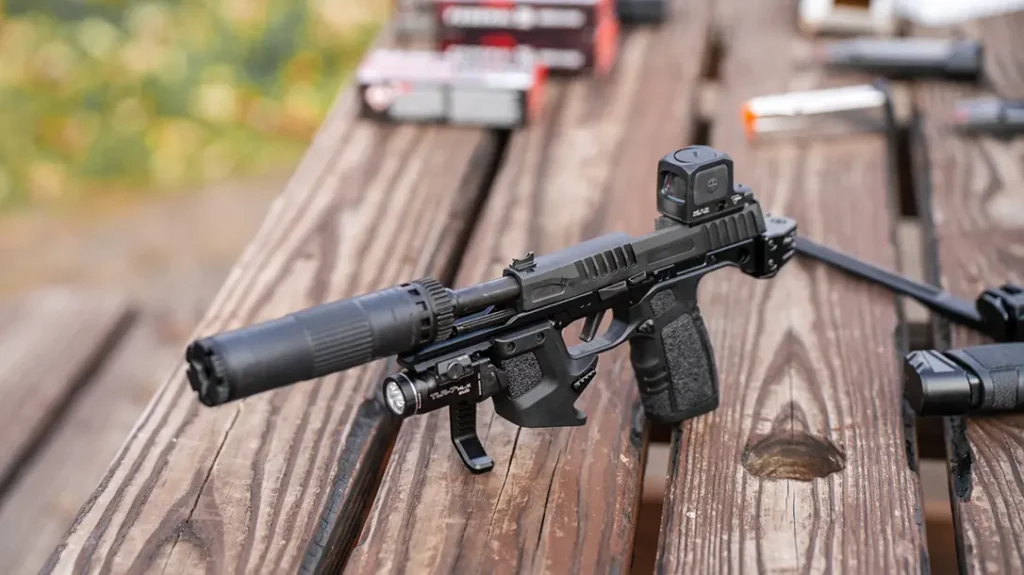For all those Americans who accidentally lost their bump stocks in boating accidents over the past few years, it’s time to head to the lake and try to fish them out again!
Supreme Court Strikes Down Bump Stock Ban 6-3!
Earlier today, the U.S. Supreme court in a 6-3 vote struck down the bump stock ban instituted by the Department of Justice under the Trump Administration. Under that Final Rule, bump stocks were redefined as “machine guns” for the purpose of the Gun Control Act and were to be regulated in the same manner as fully-automatic firearms.
The question before the court was whether a bump stock was actually a machine gun under federal law. And six justices—John Roberts, Clarence Thomas, Samuel Alito, Neil Gorsuch, Brett Kavanaugh and Amy Coney Barrett—concluded that the two were not the same.
Advertisement — Continue Reading Below
In his opinion for the majority, Justice Clarence Thomas wrote what many gun owners have known all along.
“We hold that a semi-automatic rifle equipped with a bump stock is not a ‘machine gun’ because it cannot fire more than one shot ‘by a single function of the trigger,’” Justice Thomas wrote. “And, even if it could, it would not do so ‘automatically.’ ATF therefore exceeded its statutory authority by issuing a Rule that classifies bump stocks as machineguns.”
Thomas continued: “Semi-automatic firearms, which require shooters to reengage the trigger for every shot, are not machine guns. This case asks whether a bump stock—an accessory for a semi-automatic rifle that allows the shooter to rapidly reengage the trigger (and therefore achieve a high rate of fire)—converts the rifle into a ‘machine gun.’ We hold that it does not.”
Advertisement — Continue Reading Below
ATF Argument “Logically Inconsistent”
In the majority opinion, Thomas explained how the ATF’s argument in justifying the ban actually didn’t make any sense when closely scrutinized.
“The position that ATF and the dissent endorse is logically inconsistent,” Thomas wrote. “They reason that a semi-automatic rifle equipped with a bump stock fires more than one shot by a single function of the trigger because a shooter ‘need only pull the trigger and maintain forward pressure’ to ‘activate continuous fire.’ If that is correct, however, then the same should be true for a semi-automatic rifle without a bump stock. After all, as the dissent and ATF themselves acknowledge, a shooter manually bump firing a semi-automatic rifle can achieve continuous fire by holding his trigger finger stationary and maintaining forward pressure with his non-trigger hand.
“Yet, they agree that a semi-automatic rifle without a bump stock ‘fires only one shot each time the shooter pulls the trigger.’ Their argument is thus at odds with itself.”
Advertisement — Continue Reading Below
Then, possibly referring to shooting superstar Jerry Miculek and a few other fast shooters known to the public, Thomas drove the final nail in the bump stock ban coffin.
“A bump stock does not convert a semi-automatic rifle into a machine gun any more than a shooter with a lightning-fast trigger finger does,” he concluded.
Challenging DOJ & ATF Ban
The case, Garland v. Cargill, revolved around the bump stock ban instituted by the DOJ and ATF after a horrible mass murder in Las Vegas in 2017. While instituted by the Trump Administration, the Biden Administration has been defending the ban in court since the current president took office in January 2021.
Advertisement — Continue Reading Below
In his concurring opinion, Justice Samuel Alito addressed the horrible shooting in Vegas.
“I join the opinion of the Court because there is simply no other way to read the statutory language,” Alito wrote. “The horrible shooting spree in Las Vegas in 2017 did not change the statutory text or its meaning. That event demonstrated that a semi-automatic rifle with a bump stock can have the same lethal effect as a machine gun, and it thus strengthened the case for amending §5845. But an event that highlights the need to amend a law does not itself change the law’s meaning.”
Writing for the liberal minority, Justice Sonia Sotomayor criticized the majority justices for a decision that she said would lead to “deadly consequences.”
Advertisement — Continue Reading Below
Big WIN for 2A!
“Today, the Court puts bump stocks back in civilian hands,” Justice Sotomayor wrote. “To do so, it casts aside Congress’s definition of ‘machine gun’ and seizes upon one that is inconsistent with the ordinary meaning of the statutory text and unsupported by context or purpose.
“When I see a bird that walks like a duck, swims like a duck, and quacks like a duck, I call that bird a duck. A bump-stock-equipped semi-automatic rifle fires ‘automatically more than one shot, without manual reloading, by a single function of the trigger.’ Because I, like Congress, call that a machine gun, I respectfully dissent.”
Justice Sotomayor was joined on the minority by Justices Elena Kagan and Ketanji Brown Jackson.
Advertisement — Continue Reading Below
On January 9, 2023, Tactical Life reported:

Following the unfortunate tragedy in Las Vegas in 2017, President Trump signed an executive order directing the Attorney General to regulate bump stocks. Following the EO, the ATF ordered that all owners destroy or turn in their bump stock within 90 days (story below). However, the U.S. Court of Appeals recently ruled that the ATF did not have that authority; only Congress does. As a result, the ban has been struck down.
Advertisement — Continue Reading Below
Federal Court Strikes Down Bump Stock Ban
Since its inception, the bump stock ban has survived challenges at the Cincinnati-based 6th U.S. Circuit Court of Appeals, the Denver-based 10th Circuit, and the federal circuit court in Washington.
However, on September 13, 2022, the New Orleans-based U.S. 5th Circuit Court of Appeals heard the arguments. Following this most recent challenge, the court struck the ban down in a 13-3 decision. But the court did not find the ban unconstitutional on the grounds of Second Amendment infringements. Instead, the court ruled on the lack of authority for the ATF to change laws.
According to Fox News, “In a 13-3 decision, the 5th Circuit Court of Appeals in New Orleans held that the Bureau of Alcohol, Tobacco, Firearms and Explosives (ATF), acting under ‘tremendous’ public pressure, short-circuited the legislative process by approving a rule to define bump stocks as ‘machineguns,’ which are heavily restricted. The court said ATF did not have the authority from Congress to do so.”
Advertisement — Continue Reading Below
Likewise, Rich Samp, attorney for the appellant, said in a statement posted to Fox News that “[t]his case is not about gun control. It is instead about who has the constitutional prerogative to change the criminal law if changes are warranted. The current statute, adopted in 1986, defines ‘machinegun’ in a manner that does not encompass non-mechanical bump stocks. It is unlawful for a prosecutorial entity like ATF to rewrite existing law without authorization from Congress. Any change in gun-control laws must emanate from Congress.”
Do Not Meet the Definition of Machinegun
The ban required the ATF to redefine bump stock-enabled firearms as “machineguns” under the National Firearms Act of 1934 and the Gun Control Act of 1968. This reverses a decades-old decision that bump stocks are not machine guns.
Breitbart News posted a copy of the DOJ’s summary of the ban at the time, which states:
“The Department of Justice is amending the regulations of the Bureau of Alcohol, Tobacco, Firearms, and Explosives (ATF) to clarify that bump-stock-type devices-meaning “bump fire” stocks, slide-fire devices, and devices with certain similar characteristics-are “machineguns” as defined by the National Firearms Act of 1934 and the Gun Control Act of 1968 because such devices allow a shooter of a semiautomatic firearm to initiate a continuous firing cycle with a single pull of the trigger.”
However, the appellant, Michael Cargill, successfully argued that bump stocks do not meet the definition of “machinegun” under federal law. His argument successfully illustrated that the trigger functions multiple times to fire the rifle. Federal law states that a machine gun operates with a “single function of the trigger.”
In the lead majority opinion, Judge Jennifer Walker Elrod states, “A plain reading of the statutory language, paired with close consideration of the mechanics of a semi-automatic firearm, reveals that a bump stock is excluded from the technical definition of “machinegun” set forth in the Gun Control Act and National Firearms Act.”
Gun Owners of America posted to Twitter that the ruling could set precedence for future gun rights battles as well:
But we’re not out of the woods yet, the Biden administration, which defended the law in court, may appeal to the U.S. Supreme Court.
On December 21, 2018, Tactical Life reported:
Bump Stock Owners: What You Need to Know After ATF Ruling
So the other shoe finally dropped. As you likely know by now, the Bureau of Alcohol, Tobacco, Firearms, and Explosives (ATF) recently announced its amended ruling on bump stock-type devices. Following President Trump’s demands, the ATF ruled that all bump stocks now fall within the definition of “machinegun” under federal law.
In short, following the Las Vegas shooting, Trump decided these devices needed to go, so he demanded ATF change its ruling. Meanwhile, the NRA, while publicly stating its disappointment in the ban, mostly maintained support of the president.
Conversely, the Firearms Policy Coalition (FPC), with Tim Harmsen of Military Arms Channel fame as plaintiff, filed suit. Lead counsel in this suit includes Joshua Prince and Adam Kraut, known civil rights attorneys. But only time will tell if FPC and its allies can successfully get the ruling overturned.
In the meantime, the ruling now requires all device owners to destroy their devices or abandon them at a local ATF office. If choosing to destroy the device, it is the owner’s responsibility to ensure the device is rendered incapable of being readily restored to its intended function, according to ATF.
For anyone wishing to abandon their device, you can visit Local ATF Offices to find a location near you. For those planning to destroy their device, see the list of destruction instruction links, by manufacturer, below:
ATF Bump Stock Destruction Information
- Slide Fire Solutions
- Bump Fire Systems AR and AK
- Michael Wolff (IQ #304609)
- Phoenix Technologies (IQ #76598)
- Vincent Troncoso Bump Fire Device (IQ #302683)
- Michael Smith (IQ #76715)
- Paul Ruble 10/22 Bump Fire Stock (IQ #303826)
- Slide Fire Solutions AR Pistol Bump Fire Device (IQ #304071)
- JT Grip Solutions Bump Fire Grips (IQ #303318)
- Saigatechusa/Ramlake, LLC AK Bump Stock Device (IQ #76600)
- FosTech Outdoors Bumpski AK Bump Stock (IQ #77918)
- Michael Foeller AK Bump Stock (IQ #72350)
- James Erskine Hailstorm (IQ #78025)
- David Compton Bump Fire Stock (IQ #74544)
- Mike DeWitt Chuckbuster Bump Fire Grip (IQ #303195)
All bump stock owners have 90 days from the date of publication to comply by either abandoning or destroying their device. Failure to do so would put owners in direct violation of federal law.
The ATF has compiled a lot of information regarding the new ruling; for more, visit atf.gov.
























